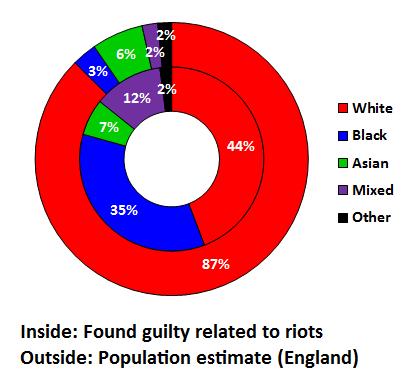Were the rioters "disproportionately black"?
Almost a year on from the summer riots in England, and plenty of debate still exists between commentators over how the events of last August should be interpreted.
Readers of this morning's Telegraph were treated to the views of Professor David Starkey, who has been no stranger to the debate ever since the analysis of the events began almost as soon as the brooms had been downed.
Today Prof. Starkey brought race (or 'culture') back onto the agenda by attacking the "nonsense" put about by the likes of Prime Minister David Cameron and Max Wind-Cowie of the Demos think-tank. Both had indicated that they thought the riots were not about race, in spite of "clear" evidence to the contrary.
Prof. Starkey was referring to the Ministry of Justice's own statistics on the individuals involved in the riots last year which, in the words of the outspoken academic, provide an "unvarnished picture" of the role of race in the disturbances. According to the professor:
"it is incontrovertible: 41 per cent of those charged were white, 50 per cent black or mixed race, 7 per cent Asian and 2 per cent Chinese or other. These figures must of course be read against the proportion of the various groups in the population as a whole: in London, to which some two thirds of the cases relate, some 12 per cent of the population is black and 69 per cent is white. Whites, in other words, were significantly under-represented among the rioters; while blacks were four times over-represented.
"The conclusion is inescapable and painful. Far from being merely opportunistic, the core of the rioters was formed of an already existing criminal class and that class is disproportionately black. This is the reality."
So are the professor's stats right? A quick look at the extensive data tables themselves confirms many of the figures. Taking all 3,051 individuals taken to a 'first hearing' and excluding those who had no recorded ethnicity, 41 per cent were white, 38 per cent black, 12 per cent mixed, 7 per cent Asian and 2 per cent Chinese or other.
However, what this ignores is that 460 of these were acquitted or had their cases dismissed, and 623 cases still don't have a final outcome, so we yet can't fairly say that any of these people necessarily form part of a "criminal class".
If we limit the sample just to those 'found guilty', 44 per cent are white compared to 35 per cent black, 12 per cent mixed, 6 per cent Asian and 2 per cent for others.

However accounting for population, using estimates from the Office for National Statistics (ONS) on population by ethnicity, Prof. Starkey certainly has a point in asserting that the rioters were disproportionately black:

Is this useful?
That the rioters were disproportionately black is certainly borne out by the statistics, however coming to the conclusion that the riots should therefore be interpreted as 'race riots' isn't a conclusion reached by those who have done extensive research into the disorder.
Prof. Starkey at one point cites the Riots Communities and Victims panel who released a report on the causes of the riots and potential solutions to prevent them from occuring again. He quotes them as asserting that "we do not believe these were race riots" but accuses them of failing to back this up with evidence.
In fairness to the panel, their position on race is laid out in more detail in their interim report published in April this year. Here they state:
"These were not race riots. They differed considerably from riots in previous years such as 1981 and 1985. We cannot discount the fact that some rioters may have been motivated by issues of race. However, aside from the riots in Tottenham (explored in chapter six), evidence from people involved, eye-witnesses and the arrest statistics suggests that in most cases, the primary motivation for rioting was theft."
The panel clearly does not discount the race factor but, based partly on eye-witness evidence, suggests others are more important.
The National Centre for Social Research (NatCen), also conducted interviews and discussion groups in November last year focusing on young people and their motivations for involvement in the riots. Race barely featured in their study, with the primary cause assigned to peer pressure, previous criminality and poverty. A similar approach was adopted by the Guardian, again suggesting there was more to the riots than race alone.
Professor Starkey isn't wrong to raise the issue of race, and the statistics do clearly show disporportionately high numbers of black people potentially involved in the riots. However this doesn't necessarily mean that there is a causal link. The rioters can be characterised by multiple other demographic factors such as age and socio-economic background and studies that have been conducted seem to recognise this.